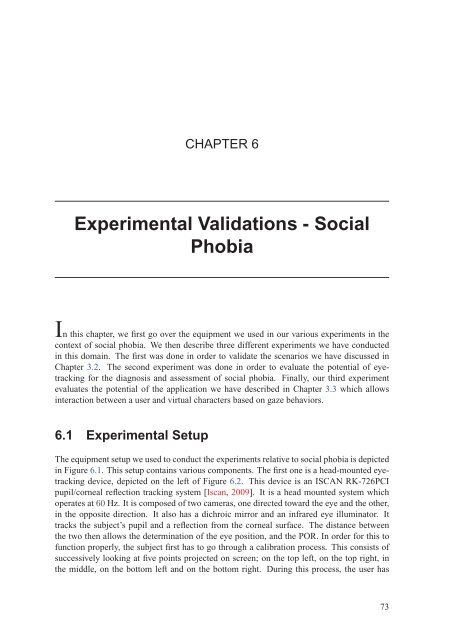Texte intégral / Full text (pdf, 20 MiB) - Infoscience - EPFL
Texte intégral / Full text (pdf, 20 MiB) - Infoscience - EPFL
Texte intégral / Full text (pdf, 20 MiB) - Infoscience - EPFL
You also want an ePaper? Increase the reach of your titles
YUMPU automatically turns print PDFs into web optimized ePapers that Google loves.
CHAPTER 6<br />
Experimental Validations - Social<br />
Phobia<br />
In this chapter, we first go over the equipment we used in our various experiments in the<br />
con<strong>text</strong> of social phobia. We then describe three different experiments we have conducted<br />
in this domain. The first was done in order to validate the scenarios we have discussed in<br />
Chapter 3.2. The second experiment was done in order to evaluate the potential of eyetracking<br />
for the diagnosis and assessment of social phobia. Finally, our third experiment<br />
evaluates the potential of the application we have described in Chapter 3.3 which allows<br />
interaction between a user and virtual characters based on gaze behaviors.<br />
6.1 Experimental Setup<br />
The equipment setup we used to conduct the experiments relative to social phobia is depicted<br />
in Figure 6.1. This setup contains various components. The first one is a head-mounted eyetracking<br />
device, depicted on the left of Figure 6.2. This device is an ISCAN RK-726PCI<br />
pupil/corneal reflection tracking system [Iscan, <strong>20</strong>09]. It is a head mounted system which<br />
operates at 60 Hz. It is composed of two cameras, one directed toward the eye and the other,<br />
in the opposite direction. It also has a dichroic mirror and an infrared eye illuminator. It<br />
tracks the subject’s pupil and a reflection from the corneal surface. The distance between<br />
the two then allows the determination of the eye position, and the POR. In order for this to<br />
function properly, the subject first has to go through a calibration process. This consists of<br />
successively looking at five points projected on screen; on the top left, on the top right, in<br />
the middle, on the bottom left and on the bottom right. During this process, the user has<br />
73

















